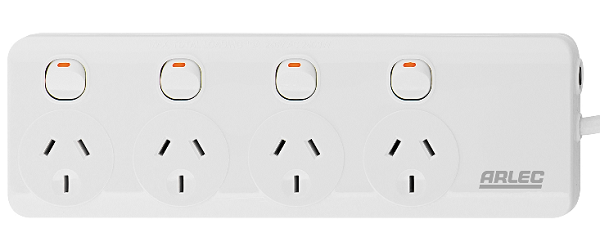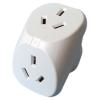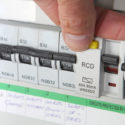
Choosing the Right Powerboard
09/10/2013How Safe Is That Double Adaptor?
Today I want to talk to you about a very common electrical appliance and a very cheap one cost less than two dollars but it’s one that can present some real dangers wherever they’re used, danger to the user, danger to the building and even appliances that are used with it.
to the user, danger to the building and even appliances that are used with it.
I’m talking about a good old double adapter.
You’ve probably got a few of these in your workplace you might even have a couple of them at home.
The common one is like that, it’s just a little piggy back that we call it or there are some others that are flat design.
Whichever, they are essentially the same; you plug it into the power point and then you’ve got two extra outlets you can plug a lead in or you can plug the appliance directly into it.
The problem with these is that they’re very old technology and they haven’t kept up with modern safety standards yet they’re still allowed to be sold and they’re readily available right across
Australia.
One of those safety features is the overload protection. You’ll notice the double adaptor doesn’t have one so if the appliances that you plug into it draw too much current the actual double adapter can get warm. It can even get hot and if that happens the plastic can start to melt and create a short circuit, then you’ve got a fire. Not a good situation.
Likewise by the nature of their design you plug them into a power point and all the weight tends to pull them out of the power point and it opens up a little gap between the face of the power point and the back of the double adapter and exposes those two pins.
If a piece of metal drops across there you end up with a complete short-circuit and that would create a huge overload situation which could damage the electrical appliances that are plugged into it. It could also cause a fire, it could burn the building down.
Here’s a real life example; this was given to me by one of our clients – as he said he was working at his desk and he pushed papers across and the next thing he heard a bang and a big puff of smoke came up. What happened was a paperclip had fallen off his desk and it landed in between the gap there. The two leads that he had plugged into it slowly opened that gap up just enough that the paperclip when it fell down it landed in there across the two pins and created a complete short circuit. Fortunately that paper clip was of a very lightweight design and it acted like a fuse and it melted and the situation stopped in about half a second or so but as you can see it caused a fair bit of damage there and also to the power point.
Now what I’d like you to consider is what if that wasn’t a lightweight paper clip, what if it was a metal letter opener or maybe it was his car keys. In that situation if that had happened he would have had a very serious overload situation with that complete short-circuit and probably would have ended up with a fire and any of the appliances that have plugged into it would have been damaged. Not a good situation and one that can easily be avoided.
What we recommend to our clients is if they’ve got any of these just throw them out and swap them over for something just a little bit more expensive; instead of that two dollar double adapter maybe a four or five dollar power board like this four output device. What you’ll notice is that all powerboards sold in Australia must have an overload device. So at least you’re one step up on the double adapter. There’s a lot of other features that you could go for with your power board and we’ll talk about that in another episode but my advice to you don’t risk everything that you’ve worked for just for the sake of a two dollar
appliance, it’s not worth it.
If you’ve got these throw them out replace them with a power board, they are much safer and you could be protecting your business, you might even save a life.
Until next time take care keep safe
Take care
Keep safe
John Blackburn
Director and Founder
ACME Test and Tagging
See also: Choosing The Right Powerboard
This information is general in nature, should be used as a guide only and read in conjunction with the relevant Standard(s), State and/or Federal Legislation, Codes of Practice and Industry Standards specific to your workplace. A proper risk assessment should be under taken before acting on the information provided in this document or any related material. Further information can also be obtained from your local Workplace Authority, Electrical Safety Authority or a suitably qualified persons. This article is copyright protected.



